2014-12-19
Abstract
Although all but one of the 15 full products submitted for testing achieved a VBSpam award this month, and five of them performed so well they earned a VBSpam+ award, performance on most accounts was poorer than it has been in recent tests. Martijn Grooten has the details.
Copyright © 2014 Virus Bulletin
At the risk of repeating myself, 2014 has been an exciting year for Virus Bulletin: a few new faces have joined the company while some longer established staff have shuffled roles; we have made our content free for everyone to access; and we have run our most successful and well-attended conference to date.
Of course, we have also tested many anti-malware and anti-spam solutions, bestowing awards upon those who have earned them and providing feedback to all participants so that they can work on improving their products.
In this final VBSpam review of the year – which, for a number of reasons beyond our control, is published more than two weeks late – we look at the performance of 15 full anti-spam solutions and two DNS-based blacklists during a 16-day period in October and November. We also look back at the performance of these products during the past year.
With the publication already running late, we have switched back to a single report on this occasion, but we hope that it provides a good overview of the products’ performance, not just in this test but throughout the year.
Although all but one product achieved a VBSpam award in this test, and five of them performed so well they earned a VBSpam+ award, performance on most counts was poorer than it has been in recent tests.
The VBSpam test methodology can be found at http://www.virusbtn.com/vbspam/methodology/. As usual, emails were sent to the products in parallel and in real time, and products were given the option to block email pre-DATA (that is, based on the SMTP envelope and before the actual email was sent). Two products chose to make use of this option.
For those products running on our equipment, we use Dell PowerEdge machines. As different products have different hardware requirements – not to mention those running on their own hardware, or those running in the cloud – there is little point comparing the memory, processing power or hardware the products were provided with; we followed the developers’ requirements and note that the amount of email we receive is representative of that received by a smaller organization.
To compare the products, we calculate a ‘final score’, which is defined as the spam catch (SC) rate minus five times the weighted false positive (WFP) rate. The WFP rate is defined as the false positive rate of the ham and newsletter corpora taken together, with emails from the latter corpus having a weight of 0.2:
WFP rate = (#false positives + 0.2 * min(#newsletter false positives , 0.2 * #newsletters)) / (#ham + 0.2 * #newsletters)
Products earn VBSpam certification if the value of the final score is at least 98:
SC - (5 x WFP) ≥ 98
Meanwhile, products that combine a spam catch rate of 99.5% or higher with a lack of false positives and no more than 2.5% false positives among the newsletters earn a VBSpam+ award.
The test period started at 12am on Saturday 25 October and ran for 16 consecutive days, ending at 12am on Monday 11 November.
The test corpus consisted of 80,034 emails. 68,542 of these emails were spam, 51,471 of which were provided by Project Honey Pot, with the remaining 17,071 emails provided by spamfeed.me, a product from Abusix (the relatively small size of the Abusix corpus is due to a technicality on our side). They were all relayed in real time, as were the 11,152 legitimate emails (‘ham’) and 340 newsletters.
Figure 1shows the catch rate of all full solutions throughout the test. To avoid the average being skewed by poorly performing products, the highest and lowest catch rates have been excluded for each hour.
This graph shows that the overall performance of products was worse than in the previous test – something which affected most participating products. On several occasions the average hourly catch rate dropped below 99% – and once even well below 97%, when a number of emails spamming hotels were found hard to filter.
These emails weren’t the hardest to block in this month’s corpus though. That qualification goes to a 419 spam email, followed by an email offering a job and one promoting (supposedly) cheap loans.
In the text that follows, unless otherwise specified, ‘ham’ or ‘legitimate email’ refers to email in the ham corpus – which excludes the newsletters – and a ‘false positive’ refers to a message in that corpus that has been erroneously marked by a product as spam.
Because the size of the newsletter corpus is significantly smaller than that of the ham corpus, a missed newsletter has a much greater effect on the newsletter false positive rate than a missed legitimate email has on the false positive rate for the ham corpus (e.g. one missed email in the ham corpus results in an FP rate of less than 0.01%, while one missed email in the newsletter corpus results in an FP rate of almost 0.3%).
SC rate: 99.67%
FP rate: 0.10%
Final score: 99.03
Project Honey Pot SC rate: 99.58%
Abusix SC rate: 99.95%
Newsletters FP rate: 5.0%

Axway’s MailGate first entered the VBSpam test a year ago. The product from the Phoenix, Arizona based company had a slightly slow start, which may have been due to some issues adjusting to our test environment, but has since performed steadily, with its performance improving a little in each test.
This month, the product increased its catch rate further to 99.67%. Against that stood an increase in the false positive rates in both the ham and the newsletter corpus. This meant the product’s final score was a bit lower than it was in the last test, but Axway MailGate still easily achieves its fifth VBSpam award.
SC rate: 99.91%
FP rate: 0.00%
Final score: 99.91
Project Honey Pot SC rate: 99.90%
Abusix SC rate: 99.94%
Newsletters FP rate: 0.0%
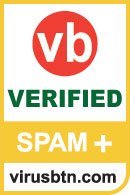
The Linux-based product from Bitdefender has participated in each of the 34 VBSpam tests we have run so far, and has never failed to achieve a VBSpam award. Moreover, since January 2013, Bitdefender has had an unbroken run of VBSpam+ awards. Against that, all concerns are pretty minor, but we have noticed a small drop in the product’s catch rate in recent months.
It was therefore nice to see that, in a test in which the performance of most products dropped, Bitdefender’s catch rate increased to more than 99.9%. On top of that, the product yet again didn’t block a single legitimate email and didn’t even block a newsletter, thus making 2014 another golden VBSpam+ year for the Romanian company.
SC rate: 98.95%
FP rate: 0.25%
Final score: 97.61
Project Honey Pot SC rate: 98.74%
Abusix SC rate: 99.58%
Newsletters FP rate: 2.9%
Egedian Mail Security was first submitted to our VBSpam lab in the spring of this year. The French product, developed by Profil Technology, achieved a VBSpam award on its first entry in May, and repeated its success in the next two tests.
Unfortunately, there was no VBSpam award for Egedian this time: the product saw a sharp drop in its catch rate – there was a lot of Asian spam among the more than 700 missed spam emails – and also saw its false positive rate increase. This was a shame, of course, and we hope that the product will be back to its usual form in the next test.
SC rate: 99.31%
FP rate: 0.00%
Final score: 99.30
Project Honey Pot SC rate: 99.14%
Abusix SC rate: 99.82%
Newsletters FP rate: 0.3%

ESET prides itself on its excellent performance in our VB100 anti-malware tests, so when the company first submitted its Mail Security product to the VBSpam tests back in 2012, the bar was already set high. It is thus perhaps little surprise that in each of the 14 tests since then (including this one), ESET has easily achieved a VBSpam award, and in six of those tests it has even earned a VBSpam+ award.
In this test, the only false positive for the product was a newsletter that, somewhat frustratingly for those working in anti-spam, addressed the recipient in a generic way. That alone wouldn’t have prevented ESET from achieving another VBSpam+ award, but unfortunately for its developers, the product’s spam catch rate dropped below 99.5%, almost entirely due to spam in east-Asian character sets. They will thus have to be satisfied with another standard VBSpam award on this occasion.
SC rate: 99.79%
FP rate: 0.00%
Final score: 99.77
Project Honey Pot SC rate: 99.75%
Abusix SC rate: 99.93%
Newsletters FP rate: 0.6%

Fortinet’s FortiMail appliance is another product that goes back a long way in our tests, to the second ever VBSpam test back in June 2009. It achieved a VBSpam award on that occasion and has done so in every test since, regularly finding itself among the top performers, while the very same box that was first submitted to us is still humming along nicely in our test lab.
The product’s 33rd test was a good one: although the spam catch rate dropped slightly, that was the case for most products this month, and at 99.79% it was still pretty good. More importantly, FortiMail didn’t miss any email in the ham corpus, and missed just two newsletters. It thus wins its fifth VBSpam+ award.
SC rate: 99.09%
FP rate: 0.00%
Final score: 99.09
Project Honey Pot SC rate: 98.89%
Abusix SC rate: 99.68%
Newsletters FP rate: 0.0%

It has been quite a good year for GFI MailEssentials: the product performed steadily and has not missed a VBSpam award (in fact, it has not missed one since it started participating in our tests in 2011), and it earned its fourth VBSpam+ award in the last test.
Yet again, the Windows solution had no false positives (this time there weren’t even any missed newsletters). However, this time the spam catch rate was quite a bit lower than in previous tests – too low to merit another VBSpam+ award. Noting that GFI also had issues with spam in east-Asian character sets, we are still able to award the vendor another VBSpam certification.
SC rate: 99.71%
FP rate: 0.00%
Final score: 99.70
Project Honey Pot SC rate: 99.61%
Abusix SC rate: 99.99%
Newsletters FP rate: 0.3%

There is hardly any IT-related subject in which IBM isn’t involved in some way, and thus it is hardly surprising that the industry giant has its own anti-spam solution. IBM Lotus Protector for Mail Security has been included in our tests since September 2011, and 2014 has been a pretty good year for it, easily achieving a VBSpam award in every test.
That good year ends on a high note, as with a good catch rate, no false positives and just a single newsletter misclassified, IBM achieves its first VBSpam+ award, thus rewarding the hard work of its developers.
SC rate: 99.96%
FP rate: 0.00%
Final score: 99.96
Project Honey Pot SC rate: 99.97%
Abusix SC rate: 99.94%
Newsletters FP rate: 0.0%

Kaspersky publishes a lot of research on spam trends – its quarterly reports are a must-read for anyone working in the field – and of course, the company has its own anti-spam solutions. Kaspersky Security 8 for Linux Mail Server was first submitted to our tests in the summer of 2012, after a previous Kaspersky product had performed well in earlier tests. Kaspersky LMS has never failed to achieve a VBSpam award and has already won half a dozen VBSpam+ awards, three of which were earned this year.
This final test of 2014 sees the product win yet another VBSpam+ award. This was one of only two products that didn’t see its performance on at least one of the three corpora decrease, and its spam catch rate of 99.96% is certainly impressive. The product’s 7th VBSpam+ award thus couldn’t be any more greatly deserved.
SC rate: 99.94%
FP rate: 0.05%
Final score: 99.62
Project Honey Pot SC rate: 99.93%
Abusix SC rate: 99.98%
Pre-DATA SC rate: 84.73%
Newsletters FP rate: 1.8%

At a security fair I attended earlier this year, Libra Esva displayed a poster in its booth showing its past performance in VBSpam tests and showing that the virtual product always finishes among the top few as measured by final score. Indeed, Libra Esva, which first joined the test in May 2010, has not missed a single VBSpam award since it joined, and has enjoyed an unbroken run of VBSpam+ awards since July last year.
Unfortunately, that run was broken this month thanks to six false positives, four of which were sent by the same sender and all of which had found themselves on various blacklists. It may well be that the senders are partly to blame here, but ultimately the filtering decision is made by the product. Fingers crossed this will be a one-off glitch and, noting that Libra Esva’s spam catch rate of 99.94% remains impressive, we can at least send the product’s developers another VBSpam award.
SC rate: 99.64%
FP rate: 0.05%
Final score: 99.36
Project Honey Pot SC rate: 99.53%
Abusix SC rate: 99.99%
Pre-DATA SC rate: 84.34%
Newsletters FP rate: 0.6%

Netmail Secure topped the rankings in the very first VBSpam test back in May 2009, albeit under a different name, and has been a regular participant in recent years, achieving a VBSpam+ award roughly every second test.
Unfortunately, there was no VBSpam+ award for Netmail in this test as it too had issues with six legitimate emails whose senders had ended up on blacklists. Other than that, performance remained good and yet another VBSpam award was never in question.
SC rate: 99.999%
FP rate: 0.00%
Final score: 99.96
Project Honey Pot SC rate: 99.999%
Abusix SC rate: 100.00%
Newsletters FP rate: 1.2%

VBSpam test histories don’t get any more impressive than that of OnlyMyEmail. The Michigan-based hosted solution has been included in our tests for four years and has never missed more than 0.02% of spam. This year, things were even more impressive as the product didn’t miss any legitimate email and very few newsletters, and the product achieved a VBSpam+ award in each of the last five tests.
This month, we are pleased to be able to increase that run of VBSpam+ awards to six in a row – the product missed just a single spam email out of more than 68,000, it didn’t block any of the more than 11,000 legitimate emails, and it only blocked four newsletters. It won’t be easy for OnlyMyEmail to repeat in 2015 what it achieved in 2014, but with this product one never knows.
SC rate: 99.93%
FP rate: 0.11%
Final score: 98.95
Project Honey Pot SC rate: 99.91%
Abusix SC rate: 99.98%
Newsletters FP rate: 14.7%

Virus Bulletin in general, and the VBSpam tests in particular, make a lot of use of open-source products and thus we were rather pleased when almost two years ago, we were contacted by the developers of Scrollout F1 who were interested in submitting their product.
Although a free product like Scrollout might require more adjustments from a systems administrator than a paid-for product, it has performed reasonably well (even straight out of the box) in nearly two years’ worth of testing, picking up several VBSpam awards along the way.
The last test was the first time this year that Scrollout failed to achieve a VBSpam award, so we were pleased to see that its performance had improved significantly in this test. The spam catch rate of 99.93% was particularly good to see. Of course, that is only half of the story and Scrollout did block more legitimate emails than all but two other products. Still, that wasn’t enough to deny the virtual appliance another VBSpam award.
SC rate: 99.71%
FP rate: 0.04%
Final score: 99.48
Project Honey Pot SC rate: 99.61%
Abusix SC rate: 99.99%
Newsletters FP rate: 0.0%

Sophos’s Email Appliance started 2014 on a high note with a VBSpam+ award, and while its performance has been pretty good since then, there have always been a few false positives standing in the way of it earning another such award.
Unfortunately, this test was no different as Sophos missed five legitimate emails – four of which were from the same Malawi-based sender. Note that the appliance didn’t block any newsletters, which is not surprising as Sophos has historically had little problem with this difficult feed. While the developers may be disappointed to have missed out on another VBSpam+ award, their 28th VBSpam award in as many tests is still something to be proud of.
SC rate: 99.30%
FP rate: 0.02%
Final score: 99.20
Project Honey Pot SC rate: 99.09%
Abusix SC rate: 99.94%
Newsletters FP rate: 0.6%

SpamTitan is another product whose VBSpam participation goes back to 2009, the very first year we ran these tests, and which has not missed a single test since, earning a VBSpam award on each occasion. 2014 has been a fairly good year for the product, with one VBSpam+ award and very few false positives.
In the final test of the year, SpamTitan blocked just two legitimate emails – both from the same sender in Africa – but it was also one of several products that saw quite a drop in its spam catch rate. Interestingly, almost all of the missed spam was written in English and, rather worryingly, there were quite a few phishing emails among them.
Of course, a catch rate of 99.3% is still pretty good, and the product’s 31st VBSpam award is on its way to its developers on the west coast of Ireland.
SC rate: 99.45%
FP rate: 0.14%
Final score: 98.70
Project Honey Pot SC rate: 99.27%
Abusix SC rate: 99.98%
Newsletters FP rate: 1.2%

ZEROSPAM, a hosted solution which first joined the tests in 2012, has had a good year, never failing to win a VBSpam award and picking up VBSpam+ awards in January and July.
This was one of several products for which the last test of the year proved to be the worst, with its catch rate falling and its false positive rate increasing to the second highest this month – the product blocked more legitimate emails in this test than it has done in the previous five tests together. The final score of 98.70 is still well above the VBSpam threshold though, and thus the product adds another VBSpam award to its tally, but we’re looking forward to the next test to see if ZEROSPAM can show that this was a one-time glitch.
SC rate: 37.64%
FP rate: 0.00%
Final score: 37.64
Project Honey Pot SC rate: 47.96%
Abusix SC rate: 6.51%
Newsletters FP rate: 0.0%
SC rate: 83.65%
FP rate: 0.05%
Final score: 83.38
Project Honey Pot SC rate: 78.79%
Abusix SC rate: 98.30%
Newsletters FP rate: 0.0%
Most spam filters make use of IP- and/or domain-based blacklists, and we are pleased to have been testing one of the best known among them in our VBSpam tests for many years. Spamhaus ZEN combines several IP based blacklists, while DBL (Domain Block List) is a self-describing acronym. Because these lists are designed to be used by spam filters, rather than on their own, their performance is not to be compared with that of the other participants, and though clearly falling well short of the VBSpam threshold, the products did not ‘fail’ the test.
We have been testing ZEN and DBL separately since May this year and, interestingly, the performance of the former is now lower than it has been since then, while on this occasion the DBL performed better than it has done before – though in both cases this may partially be explained by the relative sizes of the two spam feeds in this test.
While both lists continue to show their value, the six false positives the ZEN IP-blacklist gave us this time – the same six that were blocked by several other products – were a bit of a concern, as previous tests have always shown that Spamhaus tends to err on the side of caution.
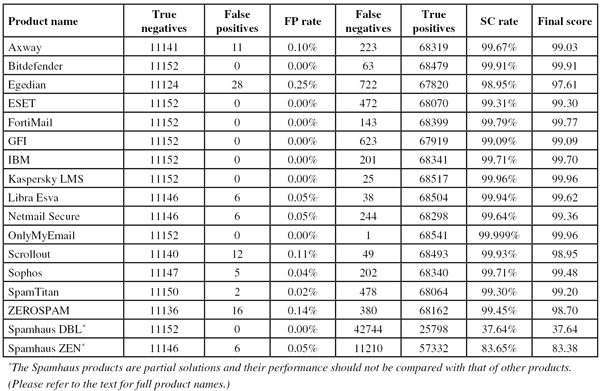
(Click here for a larger version of the table)
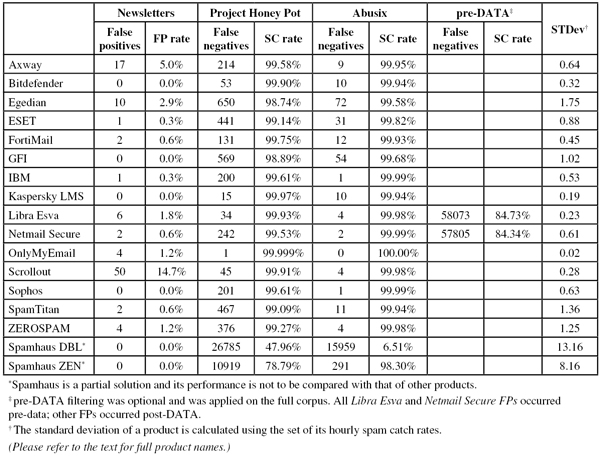
(Click here for a larger version of the table)
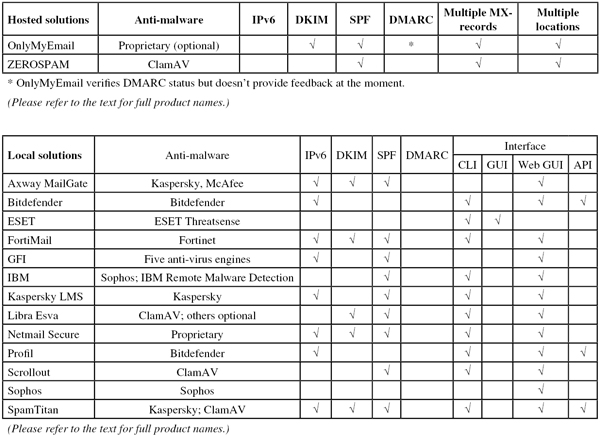
(Click here for a larger version of the table)
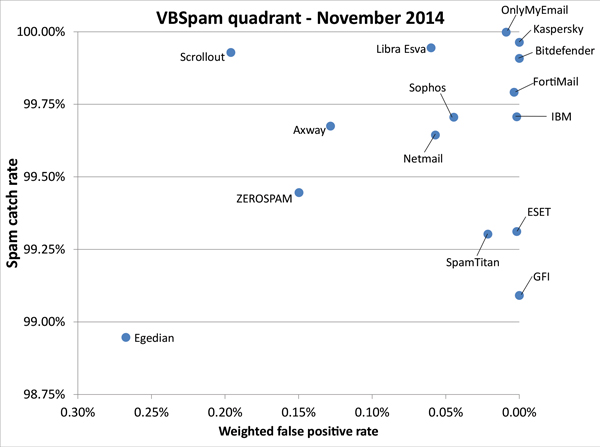
(Click here for a larger version of the chart)
This test, in which many products saw their performance drop, finished an otherwise good year for spam filters. If there’s one thing we’ve learned over all our years of running anti-spam tests it’s that spam is very volatile: this month’s drop in performance may be part of a larger trend, and it may also be a one-off thing. We hope it’s the latter, but we will report on it either way.
Stay tuned for another year’s worth of anti-spam testing. See you all in 2015!
The next VBSpam test will run in December 2014 and January 2015, with the results scheduled for publication in January. Developers interested in submitting products should email [email protected].